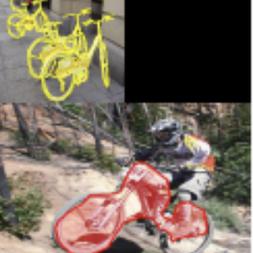Search Results for author: Neel Dey
Found 20 papers, 14 papers with code
SE(3)-Equivariant and Noise-Invariant 3D Motion Tracking in Medical Images
1 code implementation • 21 Dec 2023 • Benjamin Billot, Daniel Moyer, Neel Dey, Malte Hoffmann, Esra Abaci Turk, Borjan Gagoski, Ellen Grant, Polina Golland
Here we propose EquiTrack, the first method that uses recent steerable SE(3)-equivariant CNNs (E-CNN) for motion tracking.
Intraoperative 2D/3D Image Registration via Differentiable X-ray Rendering
1 code implementation • 11 Dec 2023 • Vivek Gopalakrishnan, Neel Dey, Polina Golland
Preoperatively, a CNN is trained to regress the pose of a randomly oriented synthetic X-ray rendered from the preoperative CT.
Shape-aware Segmentation of the Placenta in BOLD Fetal MRI Time Series
1 code implementation • 8 Dec 2023 • S. Mazdak Abulnaga, Neel Dey, Sean I. Young, Eileen Pan, Katherine I. Hobgood, Clinton J. Wang, P. Ellen Grant, Esra Abaci Turk, Polina Golland
In this work, we propose a machine learning segmentation framework for placental BOLD MRI and apply it to segmenting each volume in a time series.
Dynamic Neural Fields for Learning Atlases of 4D Fetal MRI Time-series
1 code implementation • 6 Nov 2023 • Zeen Chi, Zhongxiao Cong, Clinton J. Wang, Yingcheng Liu, Esra Abaci Turk, P. Ellen Grant, S. Mazdak Abulnaga, Polina Golland, Neel Dey
We apply our method to learning subject-specific atlases and motion stabilization of dynamic BOLD MRI time-series of fetuses in utero.
Consistency Regularization Improves Placenta Segmentation in Fetal EPI MRI Time Series
1 code implementation • 5 Oct 2023 • Yingcheng Liu, Neerav Karani, Neel Dey, S. Mazdak Abulnaga, Junshen Xu, P. Ellen Grant, Esra Abaci Turk, Polina Golland
The placenta plays a crucial role in fetal development.
Boundary-weighted logit consistency improves calibration of segmentation networks
no code implementations • 16 Jul 2023 • Neerav Karani, Neel Dey, Polina Golland
Neural network prediction probabilities and accuracy are often only weakly-correlated.
AnyStar: Domain randomized universal star-convex 3D instance segmentation
1 code implementation • 13 Jul 2023 • Neel Dey, S. Mazdak Abulnaga, Benjamin Billot, Esra Abaci Turk, P. Ellen Grant, Adrian V. Dalca, Polina Golland
Star-convex shapes arise across bio-microscopy and radiology in the form of nuclei, nodules, metastases, and other units.
$E(3) \times SO(3)$-Equivariant Networks for Spherical Deconvolution in Diffusion MRI
1 code implementation • 12 Apr 2023 • Axel Elaldi, Guido Gerig, Neel Dey
We present Roto-Translation Equivariant Spherical Deconvolution (RT-ESD), an $E(3)\times SO(3)$ equivariant framework for sparse deconvolution of volumes where each voxel contains a spherical signal.
Dual-Domain Self-Supervised Learning for Accelerated Non-Cartesian MRI Reconstruction
no code implementations • 18 Feb 2023 • Bo Zhou, Jo Schlemper, Neel Dey, Seyed Sadegh Mohseni Salehi, Kevin Sheth, Chi Liu, James S. Duncan, Michal Sofka
To this end, we present a fully self-supervised approach for accelerated non-Cartesian MRI reconstruction which leverages self-supervision in both k-space and image domains.
Data Consistent Deep Rigid MRI Motion Correction
1 code implementation • 25 Jan 2023 • Nalini M. Singh, Neel Dey, Malte Hoffmann, Bruce Fischl, Elfar Adalsteinsson, Robert Frost, Adrian V. Dalca, Polina Golland
Motion artifacts are a pervasive problem in MRI, leading to misdiagnosis or mischaracterization in population-level imaging studies.
ContraReg: Contrastive Learning of Multi-modality Unsupervised Deformable Image Registration
no code implementations • 27 Jun 2022 • Neel Dey, Jo Schlemper, Seyed Sadegh Mohseni Salehi, Bo Zhou, Guido Gerig, Michal Sofka
Establishing voxelwise semantic correspondence across distinct imaging modalities is a foundational yet formidable computer vision task.
Local Spatiotemporal Representation Learning for Longitudinally-consistent Neuroimage Analysis
1 code implementation • 9 Jun 2022 • Mengwei Ren, Neel Dey, Martin A. Styner, Kelly Botteron, Guido Gerig
Recent self-supervised advances in medical computer vision exploit global and local anatomical self-similarity for pretraining prior to downstream tasks such as segmentation.
DSFormer: A Dual-domain Self-supervised Transformer for Accelerated Multi-contrast MRI Reconstruction
no code implementations • 26 Jan 2022 • Bo Zhou, Neel Dey, Jo Schlemper, Seyed Sadegh Mohseni Salehi, Chi Liu, James S. Duncan, Michal Sofka
To these ends, we present a dual-domain self-supervised transformer (DSFormer) for accelerated MC-MRI reconstruction.
Q-space Conditioned Translation Networks for Directional Synthesis of Diffusion Weighted Images from Multi-modal Structural MRI
1 code implementation • 24 Jun 2021 • Mengwei Ren, Heejong Kim, Neel Dey, Guido Gerig
Further, such approaches can restrict downstream usage of variably sampled DWIs for usages including the estimation of microstructural indices or tractography.
Generative Adversarial Registration for Improved Conditional Deformable Templates
2 code implementations • ICCV 2021 • Neel Dey, Mengwei Ren, Adrian V. Dalca, Guido Gerig
Deformable templates are essential to large-scale medical image registration, segmentation, and population analysis.
Point-supervised Segmentation of Microscopy Images and Volumes via Objectness Regularization
1 code implementation • 9 Mar 2021 • Shijie Li, Neel Dey, Katharina Bermond, Leon von der Emde, Christine A. Curcio, Thomas Ach, Guido Gerig
Annotation is a major hurdle in the semantic segmentation of microscopy images and volumes due to its prerequisite expertise and effort.
Equivariant Spherical Deconvolution: Learning Sparse Orientation Distribution Functions from Spherical Data
1 code implementation • 17 Feb 2021 • Axel Elaldi, Neel Dey, Heejong Kim, Guido Gerig
We then show improved downstream performance on fiber tractography measures on the Tractometer benchmark dataset.
Segmentation-Renormalized Deep Feature Modulation for Unpaired Image Harmonization
1 code implementation • 11 Feb 2021 • Mengwei Ren, Neel Dey, James Fishbaugh, Guido Gerig
Deep networks are now ubiquitous in large-scale multi-center imaging studies.
Self-supervised Denoising via Diffeomorphic Template Estimation: Application to Optical Coherence Tomography
no code implementations • 18 Aug 2020 • Guillaume Gisbert, Neel Dey, Hiroshi Ishikawa, Joel Schuman, James Fishbaugh, Guido Gerig
Optical Coherence Tomography (OCT) is pervasive in both the research and clinical practice of Ophthalmology.
Group Equivariant Generative Adversarial Networks
no code implementations • ICLR 2021 • Neel Dey, Antong Chen, Soheil Ghafurian
Recent improvements in generative adversarial visual synthesis incorporate real and fake image transformation in a self-supervised setting, leading to increased stability and perceptual fidelity.











